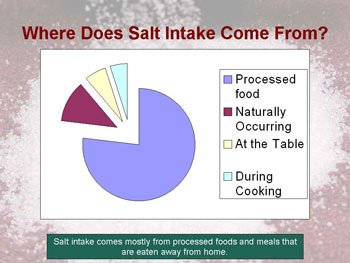1500
 That is the new amount of salt, in mg per day, recommended by the Center for Disease Control (cdc.gov) for almost 70% of all Americans - including anyone over 40, people with prehyptertension or hyptertension, and all African Americans.That is about slightly more than the amount you would get from food if you ate mostly fresh items, cooked everything yourself and avoided all processed (meaning canned, frozen and packaged foods) and restaurant food. Which is what most Americans need to do to get to that threshhold. Most get 2 or 3 times that amount each day - and 77% of that comes from food that is processed or from a restaurant.
That is the new amount of salt, in mg per day, recommended by the Center for Disease Control (cdc.gov) for almost 70% of all Americans - including anyone over 40, people with prehyptertension or hyptertension, and all African Americans.That is about slightly more than the amount you would get from food if you ate mostly fresh items, cooked everything yourself and avoided all processed (meaning canned, frozen and packaged foods) and restaurant food. Which is what most Americans need to do to get to that threshhold. Most get 2 or 3 times that amount each day - and 77% of that comes from food that is processed or from a restaurant. Here are some interesting stats from our scientist, Dr. James J. Kenney, PhD, RD, FACN, who has spent the last 12 years updating a reference paper we have on salt on our site (it is for a CPE course but anyone can read his article for free):
Here are some interesting stats from our scientist, Dr. James J. Kenney, PhD, RD, FACN, who has spent the last 12 years updating a reference paper we have on salt on our site (it is for a CPE course but anyone can read his article for free):
- Salt toxicity and subsequent hypertension (HTN) is the #1 destroyer of kidneys
- HTN is a major risk factor for senility, which can take the fun out of ones latter years.
- HTN being the #1 risk factor for stroke, which is the #1 reason people go into a nursing home for the rest of their lives.
- And while heart attacks are down, heart failure is up and the #1 cause of heart failure is salt toxicity and related HTN.
- Heart failure coupled with excess salt intake is the #1 reason Americans get admitted to a hospital.
- Heart failure is also known as congestive heart failure because fluid builds up in the lungs (causing congestions) causing shortness of breath and a slow suffocation. Living with a failing heart usually means relatively low enjoyment of life.
- Hypertension and salt toxicity greatly increase the risk of developing Atrial Fibrillation - the most common heart rythm disorder
- And let's not forget HTN and salt toxicty are major causes of the 1.5 million heart attacks each year.
- Excess salt and meat are the two major causes of kidney stones
- The increased calcium lost in the urine with each salty meals contributes to osteoporotic fractures
- Cancers of the stomach, esophagus, and kidneys are all prmoted by excessive salt intake
- Excess salt intake promotes more headaches and heartburn
- The majority of Americans have HTN by the time they are in their 60s and of those who are lucky enough to escape HTN up to age 65y two-thirds will still develop it before their 75th birthday and 90% by their 85th birthday.
- According to a recent University of Southern California study reducing salt intake by 1200mg/day (or by less than 1/3) would save as many lives over the next 10 years as if all American smokers quit tomorrow for good.
- And research shows that cutting sodium intake even more to about 1200 to 1500mg/day depending on age would virtually eliminate HTN and other lills caused largely by added ("second hand") salt.
 Of course we are busy updating our new sodium kit and will have more tips - but the easiest way to start working on your new goal of 1500 is to spend more time in the produce aisle and less where there are boxes, cans and frozen things!We also have a new DASH Poster:
Of course we are busy updating our new sodium kit and will have more tips - but the easiest way to start working on your new goal of 1500 is to spend more time in the produce aisle and less where there are boxes, cans and frozen things!We also have a new DASH Poster:


